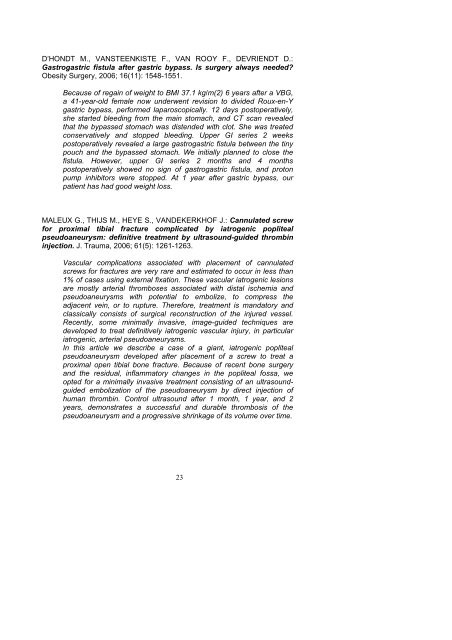2006 - UZ Leuven
2006 - UZ Leuven
2006 - UZ Leuven
You also want an ePaper? Increase the reach of your titles
YUMPU automatically turns print PDFs into web optimized ePapers that Google loves.
D’HONDT M., VANSTEENKISTE F., VAN ROOY F., DEVRIENDT D.:Gastrogastric fistula after gastric bypass. Is surgery always needed?Obesity Surgery, <strong>2006</strong>; 16(11): 1548-1551.Because of regain of weight to BMI 37.1 kg/m(2) 6 years after a VBG,a 41-year-old female now underwent revision to divided Roux-en-Ygastric bypass, performed laparoscopically. 12 days postoperatively,she started bleeding from the main stomach, and CT scan revealedthat the bypassed stomach was distended with clot. She was treatedconservatively and stopped bleeding. Upper GI series 2 weekspostoperatively revealed a large gastrogastric fistula between the tinypouch and the bypassed stomach. We initially planned to close thefistula. However, upper GI series 2 months and 4 monthspostoperatively showed no sign of gastrogastric fistula, and protonpump inhibitors were stopped. At 1 year after gastric bypass, ourpatient has had good weight loss.MALEUX G., THIJS M., HEYE S., VANDEKERKHOF J.: Cannulated screwfor proximal tibial fracture complicated by iatrogenic poplitealpseudoaneurysm: definitive treatment by ultrasound-guided thrombininjection. J. Trauma, <strong>2006</strong>; 61(5): 1261-1263.Vascular complications associated with placement of cannulatedscrews for fractures are very rare and estimated to occur in less than1% of cases using external fixation. These vascular iatrogenic lesionsare mostly arterial thromboses associated with distal ischemia andpseudoaneurysms with potential to embolize, to compress theadjacent vein, or to rupture. Therefore, treatment is mandatory andclassically consists of surgical reconstruction of the injured vessel.Recently, some minimally invasive, image-guided techniques aredeveloped to treat definitively iatrogenic vascular injury, in particulariatrogenic, arterial pseudoaneurysms.In this article we describe a case of a giant, iatrogenic poplitealpseudoaneurysm developed after placement of a screw to treat aproximal open tibial bone fracture. Because of recent bone surgeryand the residual, inflammatory changes in the popliteal fossa, weopted for a minimally invasive treatment consisting of an ultrasoundguidedembolization of the pseudoaneurysm by direct injection ofhuman thrombin. Control ultrasound after 1 month, 1 year, and 2years, demonstrates a successful and durable thrombosis of thepseudoaneurysm and a progressive shrinkage of its volume over time.23

















